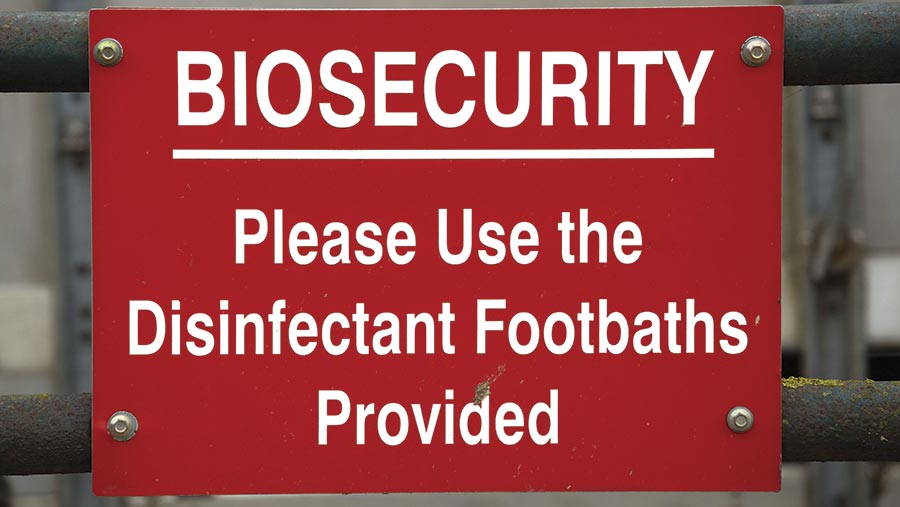4 tips to improve cleanliness and biosecurity on pig units
 © Tim Scrivener
© Tim Scrivener Cleaning and hygiene protocols help to keep out diseases and create a good impression for staff and visitors, according to pig vet Alex Thomsett from the George Veterinary Group.
Whether those visitors are vets, members of the public or footpath users, regular cleaning will help create a good impression.
A clean and well-organised unit can influence employees’ attitudes to their daily work, or affect whether a potential new recruit takes the job.
“A tidy, well-maintained farm reflects well on the whole pig sector,” Ms Thomsett says.
“The opposite is also true if management is poor. So regularly review your procedures with your vet to see if there is anything more you can do to improve unit cleanliness and protection against disease.”
She provides some pointers on what to put in place.
See also: Rules, compensation and advice for bovine TB in pig herds
1. Practise health and hygiene essentials
- Everyone entering the unit should make sure their boots have been washed before dipping in disinfectant, otherwise the foot dip is ineffective. Farmers should provide running water and a brush close to the disinfectant foot dip at the unit entry point. If this isn’t possible, a bucket and brush can be used instead.
- Foot dips should be changed whenever they are soiled and, ideally, should have a cover so they don’t get diluted by rainwater. The disinfectant may be affected by sunlight too, so if you use a coloured disinfectant and the colour fades, it might be a sign it needs changing. The main thing is to follow the manufacturer’s instructions for each product.
- Signs should make it clear where the unit entry point or line of separation is, and provide details of at least one point of contact for visitors to call on arrival.
- There should also be precise instructions on the hygiene and entry protocols – for example, where the protective clothing is kept, where to leave clothes and the need to wash boots before dipping.
- The visitor’s book should be obvious and have a working pen.

The appearance of the unit will influence visitors’ attitudes © Tim Scrivener
2. Respect procedures
- First impressions count, so a tidy unit from start to finish is more likely to encourage staff and visitors to respect procedures.
- The entry point protocol needs to appear essential, not optional. As well as having clear signage, the unit perimeter should be secure; make sure no one can just pop through a gap in the fence or an open gate. Openings make a visitor more likely to keep wandering on past the line of separation, however clear the signage is.
- Facilities and clothing need to be clean, comfortable and serviceable with a designated area for changing clothes and boots. The overalls you expect visitors to wear should not be torn, holey or stiff with muck. Dirty boots, left damp inside, do not encourage anyone to wear them. Instead, it makes visitors feel more inclined to go back to their car and grab their own boots – but you can’t be totally sure where they have been worn previously.
- Similarly, if employees are provided with clean clothing and facilities, it encourages a good attitude towards their daily work, whether consciously or subconsciously. It helps them feel valued and keen to put in the effort throughout their work, which will ultimately benefit pig health, welfare and performance.
- Adequate facilities are particularly important when you are asking for a strict biosecurity protocol to be followed. For example, a unit which asks visitors and staff to shower in and out should have warm water, a curtain, clean towels and a lock on the door. Give one member of staff responsibility for checking these things are available. Let them know how many visitors are expected so they can make sure there are enough clean towels ready and that used towels and overalls are put in the right place for washing afterwards.
- All pig units should also have adequate hand-washing facilities, which is a Red Tractor requirement. They are important for keeping both pigs and humans healthy.
3. Avoid common pitfalls
- Check that biosecurity huts are fully weatherproof so that boots and overalls stored inside are kept clean and dry.
- Signs can get sun-bleached over time so keep an eye on contact numbers and instructions and make sure they remain readable.
- Remember to shut gates at the unit perimeter once a tractor or delivery vehicle has passed through.
- Keeping the unit free of rubbish such as feed bags, string and empty medicine bottles makes a big difference to how it appears and how efficient it is to work on, and makes it less attractive to rodents which can eat valuable feed and potentially spread disease.

© Tim Scrivener
4. Follow good cleaning and disinfection
- Allow plenty of time for pens and equipment to dry fully after disinfection so that pigs are not moved into accommodation that is still damp.
- Again, make sure you remove all soiling from pig pens before disinfecting as you can’t disinfect muck. Include a detergent as it will make it easier and, potentially, quicker to remove all the soiling properly.
- Follow the manufacturer’s instructions carefully every time you use the disinfectant, to make sure it’s the right concentration and application rate. It will be more effective and avoid wasting money on excess product.
- Be aware of your herd’s health status and whether there is a specific product you can use to target a particular organism the herd might be carrying.

